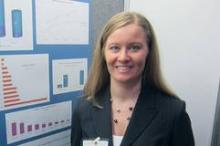Women surgeons are more likely to use assisted reproductive technology, have fewer children
AT THE ACS CLINICAL CONGRESS
WASHINGTON – Women surgeons have significantly fewer children, bear them later, and are three times more likely to use assisted reproductive techniques to achieve pregnancy, compared with the general U.S. population.
The findings probably speak to the time it takes to launch a surgical career, leading to delayed childbearing and the physiologic problems that accompany advanced maternal age, Dr. Elizabeth A. Phillips said in a poster at the annual clinical congress of the American College of Surgeons.
"Our survey found that 32% of women surgeons had difficulty with fertility at some point in their childbearing career, compared with 11% of women in the general population," said Dr. Phillips of Boston Medical Center. "When we compared the rates of fertility services to [national] data, we saw that 15% of women surgeons used assisted reproduction, compared to just 5% of the U.S. population."
She conducted an anonymous, 199-question survey on reproductive health, which was distributed to female surgeon interest groups in the areas of general surgery, gynecology, neurosurgery, ophthalmology, orthopedics, otolaryngology, plastic surgery, podiatry, and urology. She received 1,021 replies, which she compared with data from the CDC National Survey for Family Growth from 2006-2010, and the National Institutes of Health.
Of the total responses, 784 women had attempted to become pregnant. Of these, 251 (32%) reported fertility problems. Most of these (210; 84%) underwent a fertility work-up; 76% then attempted pregnancy using some form of assisted reproductive technology (ART). These women bore 185 children.
Most surgeons reported unexplained infertility (70%). Other causes were anovulation (23%); advanced maternal age or premature ovarian failure (22%); polycystic ovarian disease (19%); endometriosis (13%); and recurrent miscarriage (12%). Male factor infertility contributed to 19% of the cases.
Specialties with the highest rates of infertility were otolaryngology (29%), general surgery (22%), and orthopedics (18%).
Surgeons conceived at a significantly older age than the general population (33 vs. 23 years) did and had significantly fewer children (1.4 vs. 2.6 national average). Among those who used ART, the average maternal age at birth was even older – 35 years.
There may be several reasons why women surgeons may turn to ART so much more frequently than do nonsurgeons, Dr. Phillips said in an interview. "One theory is that female surgeons have different relationships with fertility specialists, where they are receiving treatment that would not be offered for another 45-year-old who walked into the office. They also may have the financial means to pay for this treatment."
The survey brings up the question of how women surgeons should factor childbearing into their already busy, stressful lives, she said.
"With so many more women going into surgical subspecialties, should we have family planning tracks? Is there some way to encourage women who want to become pregnant to do so during training, or shortly thereafter?"
"I’ve talked to surgeons who have been pregnant during training, residency, and practice, and by far, the best time to have a child seemed to be during residency, when there were more people to absorb the absence. But most women will say, ‘There’s never a perfect time.’ It’s something that, if it’s a goal in life, you simply have to make it a priority."
Dr. Phillips won the ACS Award for Best Scientific Poster presentation by Junior Investigator. She had no financial disclosures.





